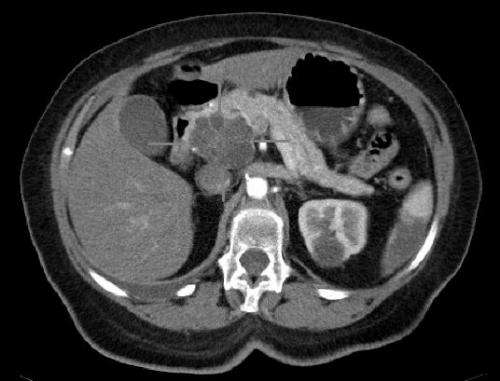This article has been reviewed according to Science X's editorial process and policies. Editors have highlighted the following attributes while ensuring the content's credibility:
fact-checked
peer-reviewed publication
trusted source
proofread
Target discovered for the treatment of pancreatic cancer

A team at the Institute of Biochemistry at Kiel University has found a way to inhibit the function of the tumor-causing protein MYC. This can be used to develop new drugs.
MYC genes and the resulting proteins are the key drivers of many types of cancer. "It really is one of the most important, if not the most important oncogene in humans," said Professor Elmar Wolf, Director of the Institute of Biochemistry of the Faculty of Medicine at Kiel University (CAU).
This is why researchers across the globe are looking for possible ways to switch off this cancer gene in order to develop new approaches to cancer treatments. However, no inhibitor has yet reached clinical application.
As it is difficult to target MYC directly, Wolf's working group is pursuing an indirect approach via the necessary binding partners. This is because the cancer-promoting function of MYC is conveyed through binding to other proteins. Wolf and his team have identified one of these essential binding partners in cell culture and animal models for pancreatic cancer.
The work, which was published in the journal Gut, demonstrates that only very few MYC binding partners are important for the progression of pancreatic cancer. One of these is the protein RUVBL1.
"The absence of this protein restricted the tumor growth of pancreatic cancer cells the most compared to the other binding partners investigated," explained first author Markus Vogt, a doctoral candidate in Wolf's working group. Switching off RUVBL1 led to a significant reduction in the size of the tumors in the pancreas and to the migration of immune cells into the tumor.
The oncogene MYC requires the protein RUVBL1 for its cancer-promoting function
This discovery was preceded by extensive work. Firstly, mass spectrometry was used to determine which proteins bind to MYC. The result was 90 proteins.
Each of these 90 binding partners was then investigated to determine which one is important for tumor growth. To this end, the researchers constructed systems in which one of these proteins was genetically switched off.
This screen was carried out both in cultured cancer cells and in the animal model for pancreatic cancer (PDAC). The study in the animal model was decisive.
"This is because many MYC binding partners proved important to cultured PDAC cells, but not in vivo," Vogt stressed. The best hit was the protein RUVBL1, said Vogt. This was then analyzed more closely in cell culture.
Subsequently, animal models were used to test whether switching off RUVBL1 actually slows tumor growth or whether existing tumors even regressed.
"We mainly used genetic methods to prevent the production of this protein. And that had a therapeutic effect. The tumors regressed and the immune system was activated," explained Wolf.
He suspects that the effectiveness is based on the fact that immune cells migrate into the tumor. Pancreatic tumors in mice, as in humans, contain only a few immune cells and are therefore considered immunologically "cold."
Accordingly, most patients with pancreatic cancer do not benefit from immunotherapies. Wolf said, "We suspect that drugs that target the MYC-RUVBL1 axis could make pancreatic tumors susceptible to immunotherapy."
Switching off RUBVL1 causes tumor to shrink
Data from human tumors confirm the importance of the protein in pancreatic cancer. According to this data, RUVBL1 protein levels are increased in tumors compared to normal, healthy tissue. And it follows the expression level of MYC.
"There are tumors that have comparatively little RUVBL1, and at the same time they also have little MYC. Tumors that have a lot of RUVBL1 also have a lot of MYC." In addition, RUVBL1 appears to be an indicator of the aggressiveness of the tumor, as mortality is higher in tumors with a lot of RUVBL1 than in tumors with little RUVBL1.
The scientists are convinced that RUVBL1 is a good target for drugs against pancreatic cancer. In the Collaborative Research Center/Transregio 387 "Functionalisation of the Ubiquitin System against Cancer—UbiQancer," which has just been approved by the German Research Foundation (DFG), they will drive forward the development of active substances.
New Collaborative Research Center involving the Institute of Biochemistry at Kiel University
The aim of the research is to facilitate the development of fundamentally new drugs against cancer. The focus is on the protein ubiquitin and the processes associated with ubiquitin. Ubiquitin is characterized by the fact that it can be attached to other target proteins, for example RUVBL1, in multiple ways and modify it in different ways.
This enables ubiquitin to fulfill various functions, for example in protein degradation, in the regulation of the cell cycle, in cellular protein transport or in the activation and inactivation of enzymes. Prof Elmar Wolf heads two sub-projects of the SFB/TRR 387.
More information: Markus Vogt et al, Targeting MYC effector functions in pancreatic cancer by inhibiting the ATPase RUVBL1/2, Gut (2024). DOI: 10.1136/gutjnl-2023-331519



















